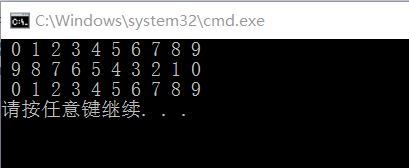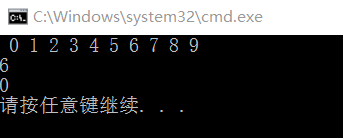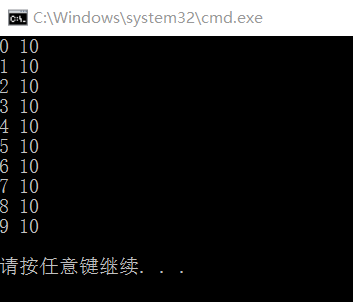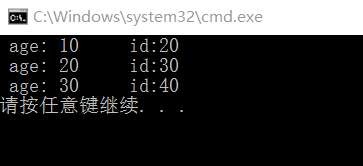函数对象设备器
- 函数对象设备器是完成一些配接工作,配接包括 绑定(bind),否定(negate),以及对一般函数或成员函数的修饰,使其成为函数对象
绑定设备器
- 作用:将二元的函数对象转成一元的函数对象
bind1st、bind2nd
- bind1st:将参数绑定为函数对象的第一个参数
#include "stdafx.h"
#include <iostream>
#include <vector>
#include <algorithm>
#include <functional>
using namespace std;
struct Print : public binary_function<int,int,void>
{
void operator()(int val1,int val2)const
{
cout << "val1:" << val1<<" val2:"<< val2<< "------->val1+val2:" << val1+ val2 << endl;
}
};
int main()
{
vector<int> v1;
v1.push_back(10);
v1.push_back(20);
v1.push_back(30);
v1.push_back(40);
v1.push_back(50);
for_each(v1.begin(), v1.end(), bind1st(Print(),100));
return 0;
}
- bind2nd:将参数绑定为函数对象的第二个参数
for_each(v1.begin(), v1.end(), bind2nd(Print(),100));
not1、not2
- not2:对二元函数对象取反
#include "stdafx.h"
#include <iostream>
#include <vector>
#include <functional>
#include <algorithm>
using namespace std;
struct Print
{
void operator()(int val1)
{
cout <<" " <<val1;
}
};
struct Compare:public binary_function<int,int,bool>
{
bool operator()(int v1, int v2)const
{
return v1 > v2;
}
};
int main()
{
vector<int> v1;
for (int i = 0; i < 10; i++)
{
v1.push_back(i);
}
for_each(v1.begin(), v1.end(), Print()); cout << endl; //原数据
sort(v1.begin(), v1.end(), Compare()); //从大到小排
for_each(v1.begin(), v1.end(), Print()); cout << endl;
sort(v1.begin(), v1.end(), not2(Compare())); //经过not2适配器,从小到大排序
for_each(v1.begin(), v1.end(), Print()); cout << endl;
return 0;
}
结果: 第一行:原始数据
第二行:从大到小排序
第三行:经过not2设备器 -> 从小到大排序
- not1:对一元函数对象取反
#include "stdafx.h"
#include <iostream>
#include <vector>
#include <functional>
#include <algorithm>
using namespace std;
struct Print
{
void operator()(int val1)
{
cout <<" " <<val1;
}
};
struct Greater5:public unary_function<int,bool>
{
bool operator()(int v1)const
{
return v1 > 5;
}
};
int main()
{
vector<int> v1;
for (int i = 0; i < 10; i++)
{
v1.push_back(i);
}
for_each(v1.begin(), v1.end(), Print()); cout << endl;
vector<int>::iterator it1=find_if(v1.begin(), v1.end(), Greater5()); //找到第一个 >5 的值
cout << *(it1) << endl;
vector<int>::iterator it2 = find_if(v1.begin(), v1.end(), not1(Greater5())); //找到第一个小于5的值
cout << *(it2) << endl;
return 0;
}
结果:第一个 >5 的值 :6 经过not1设配器 第一个小于5的值:0
ptr_fun
- ptr_fun:将普通函数修饰成函数对象,普通函数没法进行适配器操作
#include "stdafx.h"
#include <iostream>
#include <vector>
#include <functional>
#include <algorithm>
using namespace std;
void Print(int v1, int v2)
{
cout << v1 << " " << v2 << endl;
}
int main()
{
vector<int> v1;
for (int i = 0; i < 10; i++)
{
v1.push_back(i);
}
for_each(v1.begin(), v1.end(), bind2nd(ptr_fun(Print),10));
return 0;
}
mem_fun_ref
- mem_fun_ref:修饰成员函数,如果存到的是 对象使用men_fun_ref
#include "stdafx.h"
#include <iostream>
#include <vector>
#include <functional>
#include <algorithm>
using namespace std;
class Person
{
public:
Person(int age, int id) :m_age(age), m_id(id)
{
}
void Print()
{
cout << " age: " << m_age <<" id:" << m_id << endl;
}
int m_age;
int m_id;
};
int main()
{
vector <Person> v;
Person p1(10, 20) ;
Person p2(20, 30) ;
Person p3(30, 40) ;
v.push_back(p1);
v.push_back(p2);
v.push_back(p3);
for_each(v.begin(), v.end(), mem_fun_ref(&Person::Print)); //使用自己的成员函数 进行打印
return 0;
}
结果:
mem_fun
- mem_fun:修饰成员函数,如果存到的是 对象指针使用men_fun
#include "stdafx.h"
#include <iostream>
#include <vector>
#include <functional>
#include <algorithm>
using namespace std;
class Person
{
public:
Person(int age, int id) :m_age(age), m_id(id)
{
}
void Print()
{
cout << " age: " << m_age <<" id:" << m_id << endl;
}
int m_age;
int m_id;
};
int main()
{
vector <Person*> v; //存放的是对象指针
Person p1(10, 20) ;
Person p2(20, 30) ;
Person p3(30, 40) ;
v.push_back(&p1);
v.push_back(&p2);
v.push_back(&p3);
for_each(v.begin(), v.end(), mem_fun(&Person::Print));
return 0;
}
结果:






